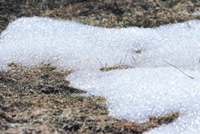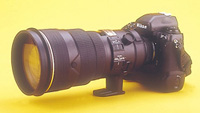Nikons New 300mm f2.8D ED IF II AF S Lens
Picking up a Nikon 300mm f/2.8 for the first time was certainly a humbling experience. This lens was not only large in physical size, it was heavy! Specifications show that it checked in at around 51/2 lbs and measured almost a foot in length. As a photographer who specializes in both outdoor photography and American railroads, it's no wonder the smaller f/4 version was my 300mm of choice over the formable 300mm f/2.8, especially when it came to mobility and hand holding convenience. But all that has changed. Radically. In its quest for smaller, lighter super telephotos, Nikon has now introduced its much improved Nikkor 300mm f/2.8D ED-IF II AF-S. Don't worry if you need a translation for all of this high-tech lingo, the important thing to remember is the "II." This is what seems to be the up and coming second generation of AF-S lenses with important new features to benefit all. Look & Feel Out of the box, one just can't help but get excited over this new Nikon addition. Nikon quality follows this lens from that substantial front element right back to the controls and CPUs that allow the lens and camera to "talk" to each other with reference to focus, distance, and exposure information that is vital today with the advent of 3D Matrix metering and balanced outdoor fill flash. |
|||
Comparing this new "II" lens to my first generation AF-S 300mm, physical size and lens makeup remain pretty much the same. With measurements of roughly 5x101/2", this lens has always been really hard to fit into your average camera bag. So along with this new lens, Nikon has thoughtfully included a ballistic nylon semi-soft case that even along with interior padding will hold the lens with a camera attached. With the wide, camera-type strap supplied and slung on your shoulder, it's almost fun to carry this lens to your next location. Nikon compresses 11 elements into eight groups, which includes three ED elements to help quell chromatic aberrations in this modern 300mm. Considering the larger 500mm and 600mm super telephotos have only one more lens element in roughly half again the overall length surely indicates this 300mm f/2.8 is one optically packed powerhouse. In addition, Internal Focusing (IF) allows for faster focusing and combined with Nikon's Super Integrated Coating offers color reproduction envied by most of its peers. Other exterior differences include redesigned rubber grips to aid in manual focusing when needed, larger numerals in the distance scales and a hollowed out rotating tripod knob for weight reduction. The lens identification label has been moved forward and reversed (black letters on a brass plate) and, finally, the limit switch letters are stamped in silver instead of white. A focus mode selector to set "M" (Manual), "A" (Autofocus), and "M/A" (Autofocus with Manual priority) allow instant switching of the lens between autofocus and manual as the situation warrants. |
|||
Silent Wave Motor Hand Holding A Long Tele |
|||
In The Field For more information, contact Nikon at (631) 547-8500; fax: (631) 547-8518; www.nikonusa.com. |
|||
Technical Specifications |






































